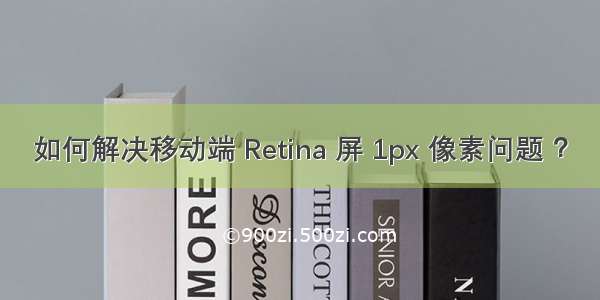
造成边框变粗的原因
其实这个原因很简单,因为css中的1px并不等于移动设备的1px,这些由于不同的手机有不同的像素密度。在window对象中有一个devicePixelRatio属性,他可以反应css中的像素与设备的像素比。
devicePixelRatio的官方的定义为:设备物理像素和设备独立像素的比例,也就是 devicePixelRatio = 物理像素 / 独立像素。
解决边框变粗的7种办法
1、0.5px边框
在的 WWDC,“设计响应的Web体验” 一讲中,Ted O’Connor 讲到关于“retina
hairlines”(retina 极细的线):在retina屏上仅仅显示1物理像素的边框,开发者应该如何处理呢。
他们曾介绍到 iOS 8 和 OS X Yosemite 即将支持 0.5px 的边框:
0.5px边框
额的神呐!so easy! 果真如此吗?
这样还不够(WWDC幻灯片通常是“唬人”的),但是相差不多。
问题是 retina 屏的浏览器可能不认识0.5px的边框,将会把它解释成0px,没有边框。包括 iOS 7 和之前版本,OS X Mavericks 及以前版本,还有 Android 设备。
解决方案:
解决方案是通过 JavaScript 检测浏览器能否处理0.5px的边框,如果可以,给html标签元素添加个class。
if (window.devicePixelRatio && devicePixelRatio >= 2) {var testElem = document.createElement('div');testElem.style.border = '.5px solid transparent';document.body.appendChild(testElem);}if (testElem.offsetHeight == 1) {document.querySelector('html').classList.add('hairlines');}document.body.removeChild(testElem);}// 脚本应该放在内,如果在里面运行,需要包装 $(document).ready(function() {})
然后,极细的边框样式就容易了:
div {border: 1px solid #bbb;}.hairlines div {border-width: 0.5px;}
优点:
简单,不需要过多代码。
缺点:
无法兼容安卓设备、 iOS 8 以下设备。
2、使用border-image实现
准备一张符合你要求的border-image:
底部边框
样式设置:
.border-bottom-1px {border-width: 0 0 1px 0;-webkit-border-image: url(linenew.png) 0 0 2 0 stretch;border-image: url(linenew.png) 0 0 2 0 stretch;}
上文是把border设置在边框的底部,所以使用的图片是2px高,上部的1px颜色为透明,下部的1px使用视觉规定的border的颜色。如果边框底部和顶部同时需要border,可以使用下面的border-image:
上下边框
样式设置:
.border-image-1px {border-width: 1px 0;-webkit-border-image: url(linenew.png) 2 0 stretch;border-image: url(linenew.png) 2 0 stretch;}
到目前为止,我们已经能在iphone上展现1px border的效果了。但是我们发现这样的方法在非视网膜屏上会出现border显示不出来的现象,于是使用Media Query做了一些兼容,样式设置如下:
.border-image-1px {border-bottom: 1px solid #666;}@media only screen and (-webkit-min-device-pixel-ratio: 2) {.border-image-1px {border-bottom: none;border-width: 0 0 1px 0;-webkit-border-image: url(../img/linenew.png) 0 0 2 0 stretch;border-image: url(../img/linenew.png) 0 0 2 0 stretch;}}
优点:
可以设置单条,多条边框没有性能瓶颈的问题
缺点:
修改颜色麻烦, 需要替换图片圆角需要特殊处理,并且边缘会模糊
3、使用background-image实现
background-image 跟border-image的方法一样,你要先准备一张符合你要求的图片。然后将边框模拟在背景上。
样式设置:
.background-image-1px {background: url(../img/line.png) repeat-x left bottom;-webkit-background-size: 100% 1px;background-size: 100% 1px;}
优点:
可以设置单条,多条边框没有性能瓶颈的问题
缺点:
修改颜色麻烦, 需要替换图片圆角需要特殊处理,并且边缘会模糊
4、多背景渐变实现
与background-image方案类似,只是将图片替换为css3渐变。设置1px的渐变背景,50%有颜色,50%透明。
样式设置:
.background-gradient-1px {background:linear-gradient(#000, #000 100%, transparent 100%) left / 1px 100% no-repeat,linear-gradient(#000, #000 100%, transparent 100%) right / 1px 100% no-repeat,linear-gradient(#000,#000 100%, transparent 100%) top / 100% 1px no-repeat,linear-gradient(#000,#000 100%, transparent 100%) bottom / 100% 1px no-repeat}/* 或者 */.background-gradient-1px{background:-webkit-gradient(linear, left top, right bottom, color-stop(0, transparent), color-stop(0, #000), to(#000)) left / 1px 100% no-repeat,-webkit-gradient(linear, left top, right bottom, color-stop(0, transparent), color-stop(0, #000), to(#000)) right / 1px 100% no-repeat,-webkit-gradient(linear, left top, right bottom, color-stop(0, transparent), color-stop(0, #000), to(#000)) top / 100% 1px no-repeat,-webkit-gradient(linear, left top, right bottom, color-stop(0, transparent), color-stop(0, #000), to(#000)) bottom / 100% 1px no-repeat}
优点:
可以实现单条、多条边框边框的颜色随意设置
缺点:
代码量不少圆角没法实现多背景图片有兼容性问题
5、使用box-shadow模拟边框
利用css 对阴影处理的方式实现0.5px的效果
样式设置:
.box-shadow-1px {box-shadow: inset 0px -1px 1px -1px #c8c7cc;}
优点:
代码量少可以满足所有场景
缺点:
边框有阴影,颜色变浅
6、viewport + rem 实现
同时通过设置对应viewport的rem基准值,这种方式就可以像以前一样轻松愉快的写1px了。
在devicePixelRatio = 2 时,输出viewport:
<meta name="viewport" content="initial-scale=0.5, maximum-scale=0.5, minimum-scale=0.5, user-scalable=no">
在devicePixelRatio = 3 时,输出viewport:
<meta name="viewport" content="initial-scale=0.3333333333333333, maximum-scale=0.3333333333333333, minimum-scale=0.3333333333333333, user-scalable=no">
这种兼容方案相对比较完美,适合新的项目,老的项目修改成本过大。
对于这种方案,可以看看《使用Flexible实现手淘H5页面的终端适配》
优点:
所有场景都能满足一套代码,可以兼容基本所有布局
缺点:
老项目修改代价过大,只适用于新项目
7、伪类 + transform 实现
对于老项目,有没有什么办法能兼容1px的尴尬问题了,个人认为伪类+transform是比较完美的方法了。
原理是把原先元素的 border 去掉,然后利用 :before 或者 :after 重做 border ,并 transform 的 scale 缩小一半,原先的元素相对定位,新做的 border 绝对定位。
单条border样式设置:
.scale-1px{position: relative;border:none;}.scale-1px:after{content: '';position: absolute;bottom: 0;background: #000;width: 100%;height: 1px;-webkit-transform: scaleY(0.5);transform: scaleY(0.5);-webkit-transform-origin: 0 0;transform-origin: 0 0;}
四条boder样式设置:
.scale-1px{position: relative;margin-bottom: 20px;border:none;}.scale-1px:after{content: '';position: absolute;top: 0;left: 0;border: 1px solid #000;-webkit-box-sizing: border-box;box-sizing: border-box;width: 200%;height: 200%;-webkit-transform: scale(0.5);transform: scale(0.5);-webkit-transform-origin: left top;transform-origin: left top;}
最好在使用前也判断一下,结合 JS 代码,判断是否 Retina 屏:
if(window.devicePixelRatio && devicePixelRatio >= 2){document.querySelector('ul').className = 'scale-1px';}
优点:
所有场景都能满足支持圆角(伪类和本体类都需要加border-radius)
缺点:
对于已经使用伪类的元素(例如clearfix),可能需要多层嵌套
参考:
《1px on retina》《再谈mobile web retina 下 1px 边框解决方案》《Retina屏的移动设备如何实现真正1px的线?》《在retina屏中实现1px border效果》作者:hlemon
链接:/p/7e63f5a32636
來源:简书
著作权归作者所有。商业转载请联系作者获得授权,非商业转载请注明出处。
















